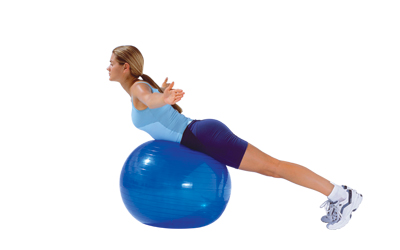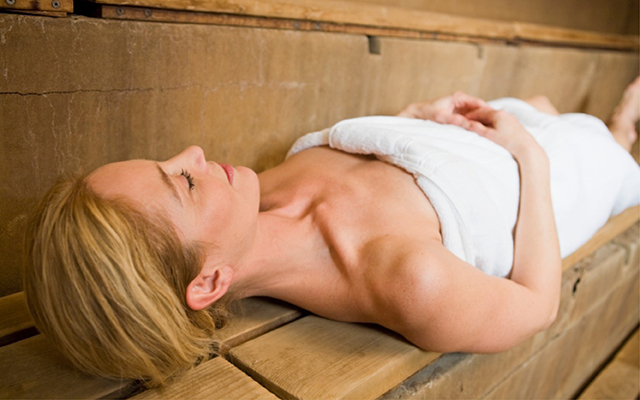Q 1: Can I avoid building thick “traps”?
I want nice shoulders and arms, but many exercises that work them also build up my traps, making my neck look shorter. Any ideas?
A. Before we talk exercises, Alli McKee, CSCS, a highly sought-after personal trainer at Evolution Sports Physiotherapy in Baltimore, suggests we examine how the trapezius muscles (or “traps”) are supposed to work. Your upper traps, the ones you see between your shoulders and neck, draw the scapulae (or shoulder blades) upward. The middle traps, draped across the upper back like a shawl, draw the scapulae in toward each other. And the lower traps, which run down the middle of your back, draw the scapulae downward.
The problem is many of us don’t properly engage the middle and lower traps, leading to chronic overuse (and overdevelopment) of the upper traps. Bad posture — shoulders hunched forward and back rounded — further feeds this imbalance by inhibiting the middle and lower traps.
The solution? Exercise in a way that helps avoid this sort of overcompensation. “Do prone Ys and Ts with your torso supported on a stability ball,” says McKee. “Machine rear-delt flies are another way to engage the backs of your shoulders and upper back while working on proper scapulae and shoulder position.” (For a video of McKee demonstrating these exercises, see the Web Extra video below.)
It’s important to use proper form, McKee points out, because there’s a tendency to let the shoulders shrug as fatigue sets in, again overengaging the upper traps. Once you get your middle and lower traps working, you’ll have more freedom to perform arm- and shoulder-shaping exercises such as overhead presses, lateral raises, biceps curls and triceps kickbacks without worrying about developing large traps. Just keep those shoulders down and away from the ears at all times, and stay clear of anything that directly engages them, such as shrugs.
Watch Show Me How: Engaging the Traps
Q2: How do I shed injury-related pounds?
I’m a triathlete, but after I injured my ankle I had to change my training regimen. I ended up gaining a few pounds. I’ve adjusted my diet, but the scale hasn’t budged. What should I do?
A. That’s gotta be frustrating. One thing to consider, though: Your body may actually be trying to help in a number of ways. “First, it’s not uncommon for triathletes to hang on to a little more subcutaneous fat [located just under the skin] than sprinters, who store more fat between their organs as a quick energy source,” says Heather Dubé, holistic nutrition consultant, personal trainer and cofounder of e3 Energy Evolved, a fitness and nutrition consulting company. “Subcutaneous fat sustains long-duration activities,” she explains. So if you’re not training as much as usual, your body might simply be stockpiling fat for when you’re ready to go again.
“Secondly, during an injury, the body lowers its resting metabolic rate in order to prioritize the new work of repair, and this makes fat loss slower,” Dubé says. Once your injury heals, your bod will rev up its metabolism.
Stress can also play a role in weight gain, causing hormonal imbalances that slow fat loss.
“I’d recommend incorporating corrective exercises to strengthen your ankle and its surrounding musculature,” says Dubé. “And cut high-intensity cardio down a bit — your body needs the energy for healing. Emphasize strength training to build muscle and increase the caloric afterburn effect. Additionally, increase your intake of essential fatty acids and cook with turmeric to lower inflammation naturally.”
Put your focus on healing and you’ll drop those extra pounds faster.
(For more see, “How to Use Active Recovery to Heal from an Athletic Injury.“)
Q3: Good ways to minimize joint pain?
Achy joints are getting in the way of my workouts. I don’t want to rely on pain meds. What can I do?
A. There are many causes of chronically creaky joints, including arthritis, injury and food intolerances. Two other common factors are inflammatory foods and muscle knots.
To address the former problem, avoid pro-inflammatory foods like flours, sugars and alcohol, and up your intake of anti-inflammatory foods like non-starchy vegetables, dark leafy greens, berries and cold-water fish. Pay special attention to your fat intake, advises Steve Gangemi, a chiropractic physician and holistic healthcare provider in Chapel Hill, N.C., and founder of the popular fitness website Sock-Doc.com.
“The natural fats present in fish oils, coconut and egg yolks can provide considerable relief,” he notes. “But it’s even more important to reduce or eliminate inflammatory fats.” Partially hydrogenated trans fats found in certain processed foods, like margarine and shortening, are best avoided at all costs, Gangemi says. Keep your intake of canola, soy, corn, safflower, sunflower and peanut oils as low as possible.
“Another common cause of joint pain is structural problems,” Gangemi says. “You may have muscle imbalances caused by trauma to surrounding tissues. You’ll know this is the case if you can find trigger points, or ‘knots,’ which are hyper-irritable spots in the muscles surrounding the joint that’s in pain.”
To release a troublesome muscle bundle, apply moderate pressure to the spot with your fingers, or massage the area for 10 to 30 seconds to release the muscle bundle. Be sure to check all the areas around the joint. If you have pain in your elbow, for example, check above your triceps, biceps, wrist extensors and wrist flexors. Sometimes you’ll experience an immediate reduction in joint pain after easing the trigger points. But if pain persists, see your healthcare provider for more suggestions.
Fitness Fix: Non-Running Sprints
Just because you’re not able to run doesn’t mean you can’t get a great sprint workout.
Not everyone can take the pounding of the pavement, but there are still plenty of ways to capitalize on the fat-burning, time-saving benefits of sprint training. “You can get the same physiological effect on a stationary bike or in the pool. Sprinting is essentially interval training — doing short bursts of intense activity followed by measured recovery periods between sets,” says Jaime Rodriguez, head strength and conditioning coach at Clarkson University in Potsdam, N.Y. “For those with injuries that keep them from running, training on the bike or in the pool are also safe solutions.”
Your work-to-rest ratio is determined by your individual fitness level and goal. If you’re training for fat loss or conditioning, your rest periods will be double or triple your work time. If you’re training for speed or power, your rest periods will be up to five times as long as your work time. You want to feel fully recovered between reps. Start out with sprints of no more than 10 seconds, and work your way up.
Sample Stationary-Bike Sprint Workouts
1. Burst Repeats
Go time: 10 seconds
Rest time: 2 to 5 times that
Rounds: 8 to 10
Effort level: 100 percent
2. Midrange Repeats
Go time: 30 seconds
Rest time: 2 to 5 times that
Rounds: 6 to 8
Effort level: 85 percent
3. Speed-Endurance Repeats
Go time: 60 to 90 seconds
Rest time: 2 to 5 times that
Rounds: 4 to 6
Effort level: 70 percent
4. Tabata Style
Go time: 20 seconds
Rest time: 10 seconds (this one is preset)
Rounds: 2 to 3; 8 sprints per round; fully recover between rounds
Effort level: 110 percent
Sample Water-Based Sprint Workouts
- Run in place in chest-high water for 10 to 90 seconds; rest two to five times that long before starting again.
- Jump up and down in chest-high water for 10 to 90 seconds; rest two to five times that long before starting again.
- Swim as fast as you can for 10 to 90 seconds; rest two to five times that long before starting again.





This Post Has 0 Comments